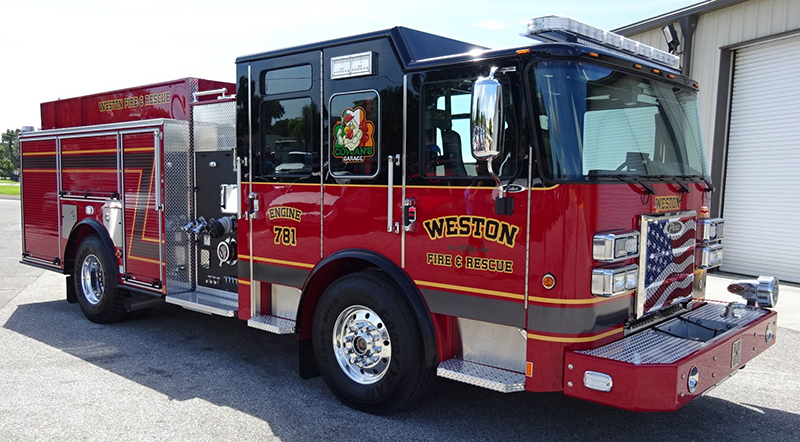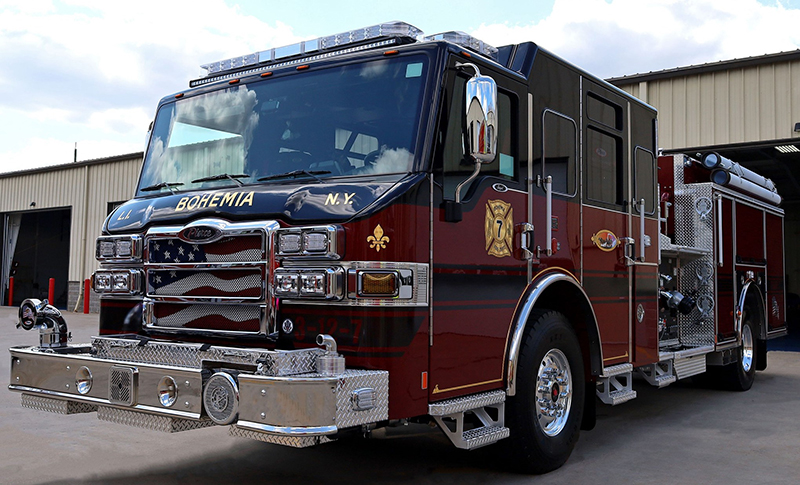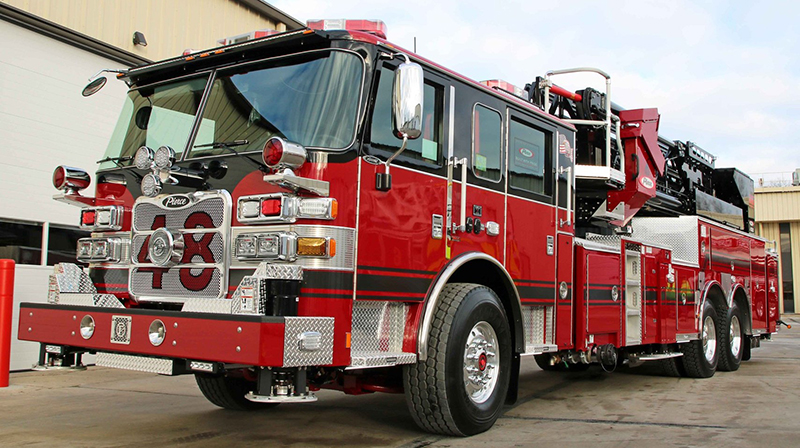By Bill Adams
Pierce Manufacturing, Incorporated, is one of the largest fire apparatus manufacturers in the nation. The company advertises six “configurations” of custom chassis with names that reflect both the cab and the chassis.
Pierce’s chassis brochure and literature illustrate the configurations with available options. They could be expounded on. Dave McAlice, the Eastern regional vice president for Pierce, agreed to be interviewed to answer some specific “how and why” questions about them.
McALICE INTERVIEW
Q: Does Pierce build cabs at the Appleton, WI, and Bradenton, FL, plants?
A: “We build cab structures at both our Appleton and Bradenton facilities. The custom cab and chassis from Bradenton is our Saber model.”
Q: Are all cabs aluminum?
A: “Yes, all our cabs are aluminum.”
Q: Are all cabs full tilt?
A: “Yes, all our cabs are full tilt. Fixed cab offerings faded away [late 1980s, early 1990s] when 4-door enclosed cabs became the industry standard. Full drivetrain and cooling system access for maintenance became much easier by tilting the cab instead of trying to access via jump seat/canopy areas.”
- First Electric Fire Truck in North America Made by Pierce Manufacturing Now in Service at Madison (WI) Fire Department
- Pierce Volterra Electric Fire Truck Named ‘Coolest Thing Made in Wisconsin 2022’
- Video: Pierce Velocity 100-Foot Platform
- Pierce Manufacturing Secures Order for 21 Fire Apparatus from AL-Based Huntsville Fire & Rescue

1 A 104-inch Velocity split cab for the East Meadow (NY) Fire Department. The 20-inch raised roof is on the stationary crew cab portion. It has optional electric flip-down steps, similar to the Quantum’s hydraulic steps. (Photos 1-3 courtesy of Pierce.)

2 A post-2014 (updated) Saber pumper for the Weston (TX) Fire Department with a 60-inch cab, a 10-inch raised roof, a one-piece windshield, and barrier doors.

3 A reintroduced Enforcer for the Nimishillen Township (OH) Fire Department. It features a 70-inch cab, a 10-inch raised roof, full-length doors, a blacked-out option, and a shroud protecting a cab roof-mounted light tower. The Enforcer allows for longer cab lengths and higher horsepower engines.

4 Three 70-inch Velocity cabs with 10-inch raised roofs and barrier doors for the East Rochester (NY) Fire Department. Two of the latest deliveries feature “spotter” mirrors to observe close to the cab’s front and, in particular, the front bumper extension work area. (Photo 4 courtesy of author.)
Q: Do you build split tilt cabs?
A: “Yes, an optional split tilt cab is available on our Velocity model in the 90-inch 3-door command-type cab and the 104-inch length for 10-person seating (photo 1). Cab lengths are from the center line of the front axle to the rear of the cab.”
Q: Any reason to do a fixed cab?
A: “No.”
Q: When Pierce’s literature and specifications state a cab width, is it internal door-to-door or external skin-to-skin?
A: “External skin-to-skin.”
Q: Are the Saber and Enforcer cab shells identical in construction?
A: “Yes. The 60-inch (photo 2) and 70-inch (photo 3) cab lengths use the same framing and shell construction methods.”
Q: Why is an 84-inch cab length available on the Enforcer and not the Saber?
A: “The Saber model currently offers the Cummins ISL-450 in the 60- and 70-inch lengths and can comfortably accommodate between four and six firefighters. The Enforcer model can include big-block diesels (500 to 605 hp) and can be increased in length to 84-inch for additional seating if desired. The differentiator is the engine and drivetrain size.”
Q: Are the Velocity and Impel cab shells identical in construction?
A: “Yes. The 60-inch, 70-inch (photo 4), and 84-inch (photo 5) cab lengths use the same framing and shell construction methods.”

5 An Impel pumper for the Bohemia (NY) Fire Department. It has an 84-inch cab with 10 seats, a 10-inch raised roof, and a compartment aft of the crew cab doors. (Photo 5 courtesy of Firematic Supply.)

6 Pierce supplied this photo of an Arrow XT pumper from the Earleigh Heights (MD) Fire Department with a 67-inch cab, a flat roof, and barrier doors common in the mid-Atlantic area. Arrow XTs have a two-piece windshield with a narrow center post. The cab tilts higher than other models for improved engine access. (Photo 6 courtesy of Pierce.)
Q: Why does the Arrow XT have 57-, 67-, and 81-inch cab lengths?
A: “The Arrow XT model design has (basically) a 3-inch incremental shorter length in each cab length mentioned previously. The original design was to maintain a short overall length for optimum maneuverability in tight city/urban streets (photo 6).”
Q: Why does the Arrow XT have an optional 16-inch raised roof and the Saber and Enforcer do not?
A: “When Pierce reintroduced the new Saber and Enforcer models in 2014, the most popular and most frequently purchased raised roof size was our 10-inch offering. For uniformity, we chose the 10-inch size, then we offer a higher 24-inch option, which blends nicely into the raised heavy rescue bodies and on top-mount enclosed pumpers.”
Q: Does each model have a “standard” interior finish with optional materials?
A: “Correct. Each model generally starts with vinyl texture paint on all metal for durability. The cab flooring uses black acoustical heavy rubber mat material. Engine tunnel covers are typically padded leather grain vinyl with walls and ceiling headliners using padded vinyl on aluminum sheets to insulate from noise and/or temperature. Inner cab door panels are brushed stainless steel. From this point, options include various spray-on liner materials, bolt-on mounting plates, tool mounting tracks, map-boxes, and consoles, etc.”
Q: Which is more popular, full height or barrier doors?
A: “This is a customer preference and can vary model year to model year. A recent customer tour through our main plants showed that the barrier-door option outnumbered the traditional full door on almost 70% of all cabs.”
Q: Which is more popular, flat or raised roofs?
A: “This is a customer preference and can vary model year to model year. The same tour showed almost nearly the same results: 60 to 70% of all apparatus had raised-roof options. Flat roofs seem popular on aerial devices (photos 7 and 8).”
Q: Do you want to “rate” the six models’ overall popularity?
A: “Overall, since the expansion of options and increased GVW ratings, the Enforcer has become our most popular model. We can offer this cab and chassis on all street or rescue pumper styles, tandem pumper-tankers, right up to every model of aerial device including the 100-foot Platform, Tower, and TDA.”
WEIGHT RATINGS
Gross vehicle weight rating (GVWR) is the maximum weight capacity of the whole vehicle. Gross axle weight rating (GAWR) references only the capacity of either the front or rear axle(s). It is common for manufacturers to generically use GVWR to indicate the weight of a specified axle. Bear in mind the axle, suspension, tires, and frame size are all contributing factors to the axle’s rating.
Q: Why is the maximum front axle GVWR on the Saber only 20,000 pounds; the Impel is 23,000 pound; and the other four models are 24,000 pounds?
A: “The 24,000-pound rating is our TAK-4™ independent front suspension rating. The 23,000-pound rating is a standard leaf spring suspension option. The 20,000-pound rating is a leaf spring suspension option available for a 10.25-inch frame rail height, of which the Saber is built upon.”

7 A flat-roofed Enforcer with a short 60-inch cab with a rear-mounted aerial for the Hopkinton (MA) Fire Department. This quint has a 600-gallon tank and a stainless-steel body. (Photo 7 courtesy of Michael Boynton/massfiretrucks.com.)

8 A flat-roofed Arrow XT mid-mount tower from the Hershey (PA) Fire Department with a 67-inch cab and 32-inch-high “can man” compartments aft of the crew cab doors for 2½-gallon water extinguishers. A mechanical Federal Q2B siren can be semi-recessed in the grille on the Arrow XT Velocity and Impel models. (Photo 8 courtesy of Pierce.)
Q: Why are there four maximum rear GVWRs between the six models?
A: “Ratings are specific to frame rail size and suspension type. Depending on the application, and which chassis model is used, there is some flexibility with single or tandem rear suspension ratings. Some examples:
“Saber: Uses 10.25-inch frame rails and offers up to a 33,500-pound single rear axle (i.e., for a 75-foot ladder application). It can an offer a tandem rear axle up to a 44,000-pound rating, popular for pumper-tanker applications.
“Enforcer: Uses either 10.25- or 13.38-inch frame rails and offers up to 33,500-pound single and now up to a 58,000-pound rating tandem for heavy duty ladder, platform, or tanker applications.
“Impel: Uses 13.38-inch frame rails and up to a 450-hp motor and offers up to a 54,000-pound capacity.
“Arrow XT Velocity and Quantum models: All use 13.38-inch frame rails and up to a 600-hp engine. Each offers up to 60,000-pound capacity for the largest aerial platform or tanker type applications.”
Q: Are there different maximum GVWRs for single rear axles on all the models?
A: “All six chassis models can offer up to the 33,500-pound capacity for a single axle, made popular with a 75- or 107-foot ladder and even on some heavy-duty rescue pumper designs.”
Q: Your literature mentions maximum cramp angles of 50° on the Saber and Enforcer and 45° on the other four. Why the difference?
A: “Cramp angles are specific to the suspension, frame rail, and running gear options selected. They will be set to the maximum possible based on the option combinations. For example, front axle ratings up to 20,000 pounds typically use size 315/80R tires, which can achieve the 50° cramp angle. Increased axle ratings that might use 385s, 425s, and even 445 size tires typically achieve the 45° cramp measurement.”
LINE-OF-SIGHT
The following question generated a lively discussion about a topic seldom addressed: the line-of-sight of the apparatus driver, regardless of being in a custom or commercial cab.
Q: Only the Quantum literature advertises the square inches in its windshield. Do you want to elaborate on the other models?
A: “Yes, but first I’d like to discuss the subject of driver visibility and ‘why we do’ and ‘what we do’ on various windshield designs. Custom fire service cab front visibility had been recognized as a weak point dating back decades, with many builders using different methods to try to gain more glass size, including moving A posts (front corners) rearward, eliminating center posts when possible, or even raising cab heights to fit a higher windshield. On several Pierce models, we’ve refined these methods to be able to use large single-piece windshields, combined with low-profile interior dashboards, resulting in a very clean line-of-sight for the driver and officer. Line-of-sight is a critical dimension. It is why several commercial chassis builders created sloped hoods for applications like school buses and urban delivery trucks. Many fire departments add ‘spotter’ mirrors on the upper right corner to help eliminate any blind spots. Better line-of-sight with greater visibility offers drivers more awareness during emergency responses, maneuvering by busy cross streets or entering intersections, resulting in greater firefighter, civilian, and pedestrian safety.”
McAlice states windshield heights on Pierce’s other models vary from 26.90 to 29.45 inches and glass surfaces vary from 2,632 to 2,960 square inches.
BILL ADAMS is a member of the Fire Apparatus & Emergency Equipment Editorial Advisory Board, a former fire apparatus salesman, and a past chief of the East Rochester (NY) Fire Department. He has 50 years of experience in the volunteer fire service.

